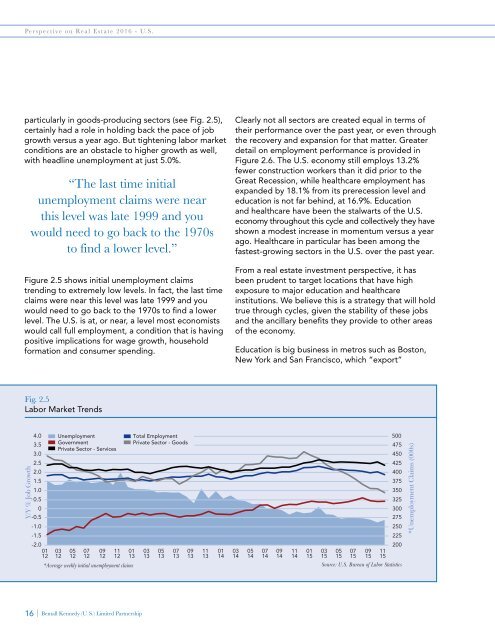BK Perspective Real Estate USA 2016
You also want an ePaper? Increase the reach of your titles
YUMPU automatically turns print PDFs into web optimized ePapers that Google loves.
<strong>Perspective</strong> on <strong>Real</strong> <strong>Estate</strong> <strong>2016</strong> - U.S.<br />
particularly in goods-producing sectors (see Fig. 2.5),<br />
certainly had a role in holding back the pace of job<br />
growth versus a year ago. But tightening labor market<br />
conditions are an obstacle to higher growth as well,<br />
with headline unemployment at just 5.0%.<br />
“The last time initial<br />
unemployment claims were near<br />
this level was late 1999 and you<br />
would need to go back to the 1970s<br />
to find a lower level.”<br />
Figure 2.5 shows initial unemployment claims<br />
trending to extremely low levels. In fact, the last time<br />
claims were near this level was late 1999 and you<br />
would need to go back to the 1970s to find a lower<br />
level. The U.S. is at, or near, a level most economists<br />
would call full employment, a condition that is having<br />
positive implications for wage growth, household<br />
formation and consumer spending.<br />
Clearly not all sectors are created equal in terms of<br />
their performance over the past year, or even through<br />
the recovery and expansion for that matter. Greater<br />
detail on employment performance is provided in<br />
Figure 2.6. The U.S. economy still employs 13.2%<br />
fewer construction workers than it did prior to the<br />
Great Recession, while healthcare employment has<br />
expanded by 18.1% from its prerecession level and<br />
education is not far behind, at 16.9%. Education<br />
and healthcare have been the stalwarts of the U.S.<br />
economy throughout this cycle and collectively they have<br />
shown a modest increase in momentum versus a year<br />
ago. Healthcare in particular has been among the<br />
fastest-growing sectors in the U.S. over the past year.<br />
From a real estate investment perspective, it has<br />
been prudent to target locations that have high<br />
exposure to major education and healthcare<br />
institutions. We believe this is a strategy that will hold<br />
true through cycles, given the stability of these jobs<br />
and the ancillary benefits they provide to other areas<br />
of the economy.<br />
Education is big business in metros such as Boston,<br />
New York and San Francisco, which “export”<br />
Fig. 2.5<br />
Labor Market Trends<br />
Y/Y % Job Growth<br />
4.0<br />
3.5<br />
3.0<br />
2.5<br />
2.0<br />
1.5<br />
1.0<br />
0.5<br />
0<br />
-0.5<br />
-1.0<br />
-1.5<br />
-2.0<br />
01<br />
12<br />
Unemployment<br />
Government<br />
Private Sector - Services<br />
03<br />
12<br />
05<br />
12<br />
07<br />
12<br />
09<br />
12<br />
11<br />
12<br />
*Average weekly initial unemployment claims<br />
Total Employment<br />
Private Sector - Goods<br />
01<br />
13<br />
03<br />
13<br />
05<br />
13<br />
07<br />
13<br />
09<br />
13<br />
11<br />
13<br />
01<br />
14<br />
03<br />
14<br />
05<br />
14<br />
07<br />
14<br />
09<br />
14<br />
11<br />
14<br />
01<br />
15<br />
03<br />
15<br />
05<br />
15<br />
07<br />
15<br />
09<br />
15<br />
11<br />
15<br />
500<br />
475<br />
450<br />
425<br />
400<br />
375<br />
350<br />
325<br />
300<br />
275<br />
250<br />
225<br />
200<br />
Source: U.S. Bureau of Labor Statistics<br />
*Unemployment Claims (000s)<br />
16 | Bentall Kennedy (U.S.) Limited Partnership


